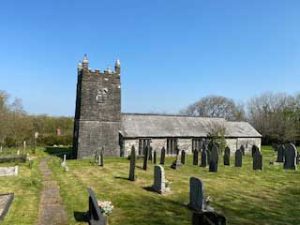
Warbstow
(Was-ta)
Accounts by Doreen Sloman and Thelma Balsdon
Warbstow was first mentioned in the Dooms Day Book in 1086 as WERBURGHASTOW – meaning `Land dedicated to the honour of St Werburgha`. This was told by someone in the village, another reason for parish connection with this Saxon Saint, could be that Warbstow was once very famous for its geese and geese do figure in the legend surrounding here.
The parish church was built by the Normans and dedicated to St Werburgha a Holy Virgin Saxon Saint, who died in the latter part of the 11th century.
Werburgha was the daughter of Wolpher, King of Mercia and granddaughter of the famous Penda, who was also a King of Mercia. Strangely though, a champion of heathenism against Christianity. Her presence in this part of Cornwall is probably due to the settlement of the Saxons here, when they pushed the Celts further down Cornwall.
The Church was originally cruciform but when partly rebuilt in the 15th century, a north aisle and Tower were added. A Norman south transept existed until drastic restoration in 1861 when it was removed. The 16th century porch has inner arch mouldings, sculptured flowers, the cross of St. John on the left, and St. Patrick on the right. Above the porch outside, is the faint impression of a cross and the date `1602`.
Parish status
The church is in a joint parish with
St Gregory’s Church, Treneglos
St Winwaloe’s Church, Poundstock
St Anne’s Church, Whitstone
Our Lady and St Anne’s Church, Widemouth Bay
St Gennys’ Church, St Gennys
St James’ Church, Jacobstow
St Mary the Virgin’s Church, Week St Mary
Surrounding Places of interest in the Parish
An animal pound is on the village green at Downinney, one of few now remaining in the country. This pound is a round earth bank topped by trees and a small gate. It was used in the past to impound straying cattle and other farm animals. Which were restored to their owners on payment of 2d.
Many events were held on the village green, band of hope, fetes and meetings. John Wesley is reputed as having preached there on several occasions.
At one end of the village green is where the original Manor of Downinney once stood, which was held after the Norman conquest, for the Count of Mortain. Mortain was the half brother of William the Conqueror, by Richard Fits-Turold, Lord of Cardeinham and Stewart of the Count`s household. The righthand side of the house frontage has been built rount the Norman door, porch and upstairs window, which are the only remains of the Manor House.
